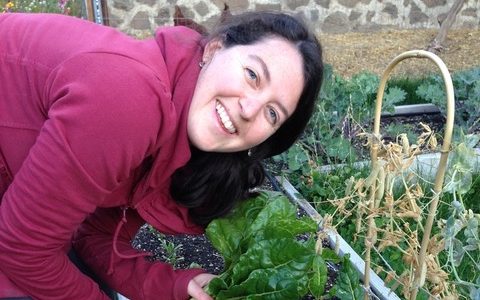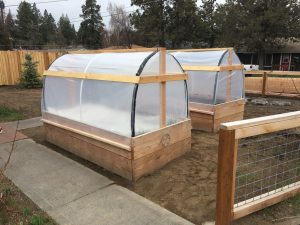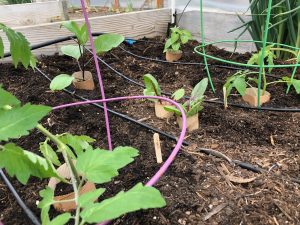Rethink Waste in and around your garden with Bend Urban Gardens

There is so much waste that can happen in backyard gardening: building materials, toxic chemicals from herbicides and pesticides, not to mention water, energy, and food waste potentials that can occur. I had a chance to sit down with a professional to learn about some best practices around waste reduction in the garden. From non-toxic alternatives to building and decorating with found materials, Ashley Joyce (in header photo) of Bend Urban Gardens tells us what’s up.
And some exciting news: it isn’t too late in the year to plant stuff! There are plenty of crops that go in for a fall harvest. Read on.
RW: Who are you? Tell us about yourself. What’s your company called and who do you serve?
AJ: I am Ashley Joyce, the founder, lead gardener, and vegetable enthusiast of Bend Urban Gardens LLC. Our mission is to bring research-based information to local gardeners through personalized on-site coaching, offering guidance for success in growing nutritious and delicious food in the high desert. Growing vegetables in Central Oregon can be intimidating and overwhelming, but we make gardening in our climate accessible through inspiration, education, and ongoing support. We serve aspiring vegetable gardeners with little to no experience growing food as well as folks who are looking to expand or improve their existing edible landscapes.
RW: What is your history with Central Oregon? How long have you been involved in gardening here and how did you get started with gardening?
AJ: I moved to Bend when I was eleven years old, but it wasn’t until my AmeriCorps VISTA service, in my early twenties, that I developed an interest in where food comes from. During that time, I volunteered on an urban farm and cared for a small container garden on my rooftop. Even though I lost my first tomatoes to city squirrels, I persevered and spent a few growing seasons interning on diversified organic vegetable farms. It was at the Center for Agroecology and Sustainable Food Systems at UC Santa Cruz (CASFS), a training program for organic farmers and gardeners, where I led farm field trips for kids, that I realized applying my food production knowledge to educating others about growing and preparing food was my niche. In 2009, after completing the program and earning a Certificate in Ecological Horticulture, I moved home to Bend and spent nearly nine years teaching nutrition, cooking, and gardening, as an educator with the OSU Extension Service SNAP-ED Program in Deschutes County.
Once back in Bend, I started gardening on a very small scale, amending patches of soil in the backyards where I lived. I was a member of the Hollinshead Community Garden for a season before finally landing at my current home, where I’ve been since 2012. In 2015, my husband and I were honored to share our garden with the community on the High Desert Garden Tour presented by the OSU Extension Service and the Central Oregon Chapter of OSU Master Gardeners. We showcased the possibilities of using season extension to grow a CSA share in a back (and now front, too!) yard in Bend, despite our unpredictable, short growing season.
RW: In regards to material waste, what are some ways you see excess pertaining to gardening, and what are some suggestions you have for creative reuse in the garden?
AJ: There are so many creative ways to upcycle materials in a garden, whether it is for building garden beds or trellises, or for decoration, depending on the aesthetic you are going for in your outdoor living space.
Old lumber: Repurposing old lumber into raised beds for edible plants is a popular way to reuse materials. However, be sure the wood isn’t treated or painted with lead paint if you are using it to grow edible plants.
Pallets: If you are going to plant directly into a pallet, look for pallets that are heat-treated instead of chemical treated, and make sure you are comfortable with where they came from.
Old tires: Also a popular material for repurposing into garden spaces, especially since they can retain heat well and offer warmth to your plants when they are in direct sunlight, although there is some evidence that chemicals in tires can leach into edible crops over time, so we don’t recommend planting food crops in tires, but you could use them for a flower garden.
Trellises: Branches, old bike wheels, and even headboards can make great trellises for viney climbing plants. If you are spending more time at home and engaging in home projects, think about the ways you can repurpose materials instead of sending them to the landfill. This season I took apart a portion of my chicken coop (to convert to more garden space, of course!) and reused the gate as a trellis for my peas!
Check out what these two Bend Urban Gardens clients did with upcycled bits for their gardens:
- Alicia made a trellis for her peas out of some trimmed branches.
- Mandy built raised beds from old found pieces of collected lumber.
One easy way to reduce waste is to get bulk soil for your raised beds instead of bagged soil.
In our household, we have accumulated a variety of bike parts over the years and have decorated our raised beds with chainrings and also used busted bike tubes as a durable protector to cover the area where our greenhouse plastic is attached to our hoop house hoops.

Cloches decorated with a bicycle chainring. Used bike tubes line the outside of the hoops for protection.
RW: What about on a smaller scale? Like just a pot of herbs?
AJ: Growing herbs in containers can be a great gateway into urban gardening. New pots can be expensive, especially large ones, but virtually any food-safe container that is at least 12 inches deep and 8 inches in diameter can make a good home for most plants. As long as there is some way for the container to allow for drainage, you can get creative. The Environmental Center has some innovative examples of rain gutter vertical gardens. Hanging shoe organizers that no longer have a clear purpose in your home after you’ve embraced a more minimalist lifestyle can be converted into gardens! Even old furniture, like dressers, can be turned into gardens.
For seed starting on a home scale or growing microgreens, try reusing plastic clamshell containers with openings at the bottom, or even making drainage holes in tofu, yogurt, sour cream, and rotisserie chicken containers (also great for an easy greenhouse).
RW: There are a lot of chemicals out there that people can purchase for use in their garden for both pesticides, herbicides, and fertilizers. What kind of non-toxic alternatives do you recommend?
AJ: Building healthy garden soil is the best thing you can do to prevent the need for pesticides and supplementing with a lot of fertilizers. Of course, even in a vegetable garden with healthy soil, there are still creatures and plant diseases that can come along, and weeds can easily outcompete your plants if they aren’t managed. Our local garden centers have a variety of non-toxic products to choose from depending on your issue.
Pesticides: For new gardeners (especially those spending a lot of time watching their plants during COVID times), it can sometimes be challenging to judge the severity of a pest issue. Simply being ok with sharing some of your plants can help you reduce the need for interventions in the first place. But, when pests are really making an impact on your ability to grow food, then some sort of intervention is usually needed. This spring, for example, cutworms devoured my spring greens. The bugs eat the bottom of the plant stems thereby killing the plant. I could’ve applied diatomaceous earth (a non-toxic pest control) once I realized that handpicking them out each day wasn’t reducing their population enough to save my plants, but I know that diatomaceous earth could’ve also done harm to beneficial insects. So, I pulled used toilet paper rolls out of my fire starting bin and made plant collars for the remaining bok choy and spinach plants as well as around my basil starts. I used coffee cup sleeves for my tomatoes. The collars protect the plants (and their stems) by being a physical barrier around the base!

Toilet paper roll and coffee sleeve collars to prevent insects from eating young greens!
I try to minimize the chance of having an infestation in the first place, by rotating my crops from season to season and attracting beneficial insects by planting flowers near my vegetable garden. Companion planting with fragrant herbs and flowers can deter some unwanted pests or become trap crops, sacrificial crops to help protect the plants you are growing for food. If those actions fail, I have had success with making a homemade insecticidal soap spray of 1 tablespoon dish soap and 1-quart water.
Herbicides: I don’t use herbicides. Solarizing and mulching are techniques I’ve practiced while apprenticing on farms to keep weeds down. Vinegar can be an effective weed killer, but I typically recommend simply using hand tools to remove weeds when they are small and easy to uproot. The hula hoe and hori hori are my favorites.
Fertilizers: Nutrients aren’t typically as accessible to plants in a new garden (or in colder spring weather), mainly since microorganisms haven’t yet had the chance to turn the nutrients in your compost and the minerals in your soil into a form that your plants can use, so a balanced organic fertilizer can really help give your plants a boost at the beginning of the season in new garden beds and throughout the season for your heavy feeding plants like tomatoes, peppers, and squash.
RW: Watering is also a big issue, especially in the heat of mid-summer in drought conditions. What are your tips for the best time to water your vegetable garden?
AJ: First, I would definitely suggest reaching out to a licensed irrigation professional to help you use water most efficiently in your landscape. Many new vegetable gardeners choose to hand water or they place their vegetable gardens near existing overhead irrigation and end up putting down way too much water at once. I recommend watering in the early morning and practicing a cycle and soak approach, watering for short intervals of time, more frequently. This helps to avoid run off and to ensure that water is getting down to the roots of your plants. Feel your soil regularly to check the soil moisture to determine if you need to adjust your watering schedule. Investing in a drip irrigation system for your veggie garden will not only save you time, but is very effective at applying water. I recommend 1/4” drip lines with emitters every 6” with lines spaced 8” apart in a garden bed. This should allow for enough lateral movement of the water to reach all of your plants right at their roots.
RW: What about some good plants for Central Oregon xeriscaping? What’s your take on lawns? Is there a responsible way to do it or should we just get rid of them?
Bend Urban Gardens specializes in edible gardening. In our demonstration garden, there are a variety of flowering landscape plants near our edible annuals and perennials to help attract pollinators. We have chosen some natives, like Oregon Sunshine and penstemons that have low water needs. Everyone has different preferences and goals for their personal landscapes. In mine, if I’m going to consume water, I want it to be helping to grow food or pollinator habitat. I know that my puppy would love to have a patch of grass to roll around on, but it motivates us to get some exercise and walk to the park for that!
RW: Would you mind highlighting one plant that does well in Central Oregon?
AJ: Just one!?! Cold tolerant greens tend to do great in Central Oregon, and growing your own salad mix can definitely help you avoid the packaging that greens tend to be sold in. Choosing more heat resistant varieties for summer and planting them to the north of tall crops or covering them with shade cloth can help you continue your harvest through the heat of summer.
It’s not too late to plant some vegetables for the fall and even to overwinter! This month, try sowing short-season varieties of beets, carrots, and leafy greens, as well as transplanting broccoli and cabbage. Plant garlic in October. At the end of August and into September, you can plant successions of spinach. It won’t grow much over the winter, but it could hold if covered with row cover and greenhouse plastic, for some fabulous early spring greens. Brassica family plants do very well in Central Oregon because they are so cold tolerant and can offer a continuous harvest throughout the growing season. Broccoli, cabbage, kale, kohlrabi, boy choy, radishes, and Hakurei salad turnips are some of my favorites.
RW: Anything else you would like to add about waste in the garden?
AJ: First off, growing an edible garden, in general, is a great way to reduce food waste for families because kids are often more likely to eat veggies that they helped grow or harvest.
Also, plant spacing is really important in the garden because plants that are spaced too close together often don’t thrive and this can impact the other plants growing around them, wasting water and energy to grow plants that aren’t able to reach maturity. Bend Urban Gardens offers personalized crop plans to help you maximize your space and increase your chance of getting a bountiful harvest from what you grow. We also offer garden lessons to help you learn when to harvest your food, so that you don’t end up wasting the food you are working so hard to grow!

